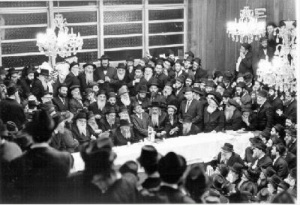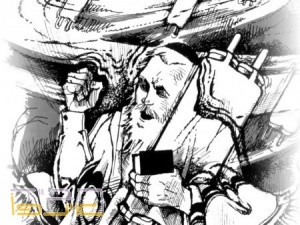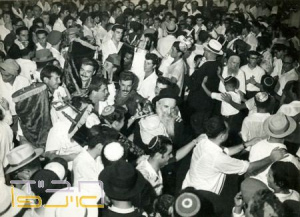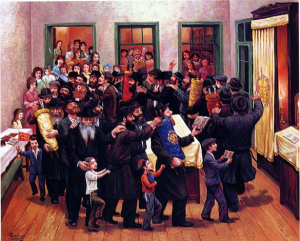Simchat torah: Difference between revisions
No edit summary Tags: Visual edit Mobile edit Mobile web edit |
No edit summary |
||
| (5 intermediate revisions by the same user not shown) | |||
| Line 1: | Line 1: | ||
Simchat Torah is celebrated on the | [[File:שמחת תורה.jpg|thumb|A rare photo from the Rebbe's farbrengen on '''Simchat Torah'''. The photo was taken by a non-Jewish reporter from the "New York Times" at a farbrengen in the year 5728/1967.]] | ||
Simchat Torah is a holiday celebrated on the last day after the conclusion of Sukkot, marking the reading of Parshat V'Zot HaBracha which completes the Torah reading cycle of all the Torah portions, and celebrating and rejoicing on the occasion of this completion. In [[Eretz Yisroel|Eretz Yisrael]], this day is celebrated together with Shemini Atzeret, on the 22nd of Tishrei; while outside of Eretz Yisrael, this day is the second holiday following Shemini Atzeret, on the 23rd of Tishrei. | |||
Our Rebbeim spoke extensively about the greatness of this holiday, | Our Rebbeim spoke extensively about the greatness of this holiday, from which joy extends throughout the entire year, and therefore one must be careful to utilize the time on this day as much as possible for rejoicing and dancing. | ||
[[File:הקפות.jpg|thumb|A drawing depicting the Hakafot conducted by Rabbi Levi Yitzchak, the Rebbe's father, during his exile in Chaili.]] | |||
== The Holiday Order and Its Customs == | |||
== Hakafot == | ==== Hakafot ==== | ||
'''Extended topic – Hakafot, Atah Hareita''' | |||
"And Israel customarily | It is a Jewish custom to circle the Torah reading platform with Torah scrolls on the night and day of Simchat Torah, with joy, songs, and dancing, celebrating in this way the completion of reading the entire Torah. This custom began in Ashkenazi lands hundreds of years ago, and from there spread to Sephardic communities. Rabbi Chaim Vital brought that his teacher the Arizal practiced this custom, and also showed a source for the custom in the Zohar:<blockquote>"And Israel customarily celebrates with it, and it is called Simchat Torah. And they crown the Torah scroll with its crown." — Zohar Part 3, 256b</blockquote>Among our Rebbeim, the Hakafot on Shemini Atzeret were conducted with seriousness compared to the Hakafot of Simchat Torah, where the joy was greater, beyond measure and limitation (although in recent years the Rebbe instituted that already on Shemini Atzeret the Hakafot should be with joy that breaks through all limitations completely, and explained the reason for this). | ||
In Chassidic teachings, the virtue of Hakafot is explained extensively, as a joy that is beyond all limitations in which all Jews unite without distinction, and this joy brings about elevation in Torah study throughout the entire year. | |||
The Rebbe Rashab once asked his father, the Rebbe Maharash: What is the meaning of Hakafot? He answered him: Hakafot means that we plead with the Father - our Father in Heaven with tears of blood, "my tears have been my bread," have mercy and break the yoke of the gentiles from our necks. The gentiles are the body and the animal soul. We dance with the Torah scroll in joy, with an open head and an open heart, but internally, tears of blood flow. | |||
== Torah | ==== Aliyah to the Torah ==== | ||
'''Extended topic – Torah Reading on Simchat Torah''' | |||
On Simchat Torah there is special care taken to ensure everyone receives an aliyah to the Torah, and in Jewish communities there are various customs whether to repeat the reading again and again until everyone merits an aliyah, or to call up several people together. | |||
Additionally, there are special customs related to the Torah aliyah, such as a special aliyah for children called "Kol HaNe'arim" (All the Youth), the aliyah of Chatan Torah and Chatan Bereishit, and special poems connected with the Torah reading. | |||
==== By the Rebbe ==== | |||
'''Extended topic – Niggunim the Rebbe Taught''' | |||
In the first years of the Rebbe's leadership, on the night of Simchat Torah after Hakafot, the Rebbe would go up to the Rebbe Rayatz's apartment and have the holiday meal there. When the meal ended, the Rebbe would return to the synagogue and teach a new, unfamiliar niggun to the chassidim who remained there and continued dancing. | |||
Usually, the Rebbe would also speak briefly about the niggun. This practice continued intermittently until 5724 (1964). | |||
The Rebbe expressed that Simchat Torah is the most appropriate time to encourage the Mivtza Torah (Torah Campaign) and the Mivtza Ot B'Sefer Torah (Letter in a Torah Scroll Campaign). | |||
==== Second Hakafot ==== | |||
[[File:הקפות שניות כפר חבד.jpg|thumb|Second Hakafot at Beit Menachem Synagogue in Kfar Chabad]] | |||
'''Extended topic – Second Hakafot''' | |||
Second Hakafot is an Eretz Yisrael custom based on the practice of the Arizal, according to which at the conclusion of Simchat Torah, another round of Hakafot with Torah scrolls accompanied by singing and dancing with musical instruments is performed. When the Arizal lived in Tzfat, he would visit synagogues that delayed finishing their prayers on the night after Simchat Torah and conducted seven Hakafot in each of them. | |||
Based on this practice, the kabbalistic circles customarily conducted second Hakafot at the end of the holiday, taking out Torah scrolls after reciting the verses of "Atah Hareita" with all the details of customs as they conduct the Hakafot on the first night. Later, the custom spread to additional synagogues in Jerusalem and other communities and cities. | |||
Over the years, several reasons were given for conducting these Hakafot, whether to participate with Jews outside of Israel in their celebrations which begin at this time when for them it is the night of Simchat Torah (since outside of Israel the holiday lasts two days), or because after the holiday ends it is permitted to play musical instruments and people can gather from more distant places to rejoice together in the joy of the Torah in a manner of "In the multitude of people is the king's glory." | |||
The Rebbe expanded and established this custom in Chabad communities in Eretz Yisrael, and exceptionally deviated from his regular practice of not writing during Chol HaMoed, sending special telegrams during Chol HaMoed of Sukkot to participants in the Second Hakafot. | |||
Every year, a central "Second Hakafot" ceremony is held at the Beit Menachem Synagogue in Kfar Chabad, attended by thousands of Jews from all segments of society, with government officials, politicians, and public figures honoring the event with their presence. | |||
== | == Throughout the Years == | ||
In the year '''5559 (1799)''' the Alter Rebbe was imprisoned. | |||
== Simchat Torah Niggunim == | In the year '''5738 (1978)''' the Rebbe suffered a heart attack. | ||
* Al HaSela Hach | |||
* Stav Ya Pitu | In the year '''5784 (2023)''' the Iron Swords War began. | ||
* | |||
* O Va Die Mi Nieotnim | == The Essence of the Holiday == | ||
* Hasa Dina Hasa | This section is incomplete. Please contribute to Chabadpedia and complete it. There may be more information on the discussion page. | ||
* | |||
* For the meal: Hop Kozak | ==== Joy for the Final Tablets ==== | ||
* Dem Rebbin's Niggun/Simchat Torah Nikolayev | On Simchat Torah we rejoice for the final tablets, which were given on Yom Kippur. | ||
* Niggun 165 - Hakafot Niggun | |||
==== Explanation of the Holiday Name ==== | |||
Regarding "Simchat Torah" there are two interpretations: (a) The Torah is in a state of joy, and therefore the Jewish people also rejoice in the Torah's joy, as in the liturgical poem "Rejoice and be happy in the joy of Torah," meaning that the Jewish people rejoice in the Torah's joy. (b) Moreover - the Jewish people bring joy to the Torah. | |||
==== Yisrael Brings Joy to Torah ==== | |||
The Torah descended from its supernal place to our lower world, and when a Jew rejoices with the Torah and dances and sings with the Torah, he adds joy to the Torah, because a Jew has the power to make a dwelling place in the lower realms, through which he draws down the Essence. | |||
==== General Joy for the Entire Year ==== | |||
The Rebbe explains that it is known that all matters of the month of Tishrei are general matters, and similarly, the joy of Shemini Atzeret and Simchat Torah is a general, comprehensive joy from the essence of the soul, which includes all powers as one. And similarly regarding the aspect of time - this is not just a joy that belongs to this particular time, but a general joy for the entire year. For this reason, the joy needs to be beyond reason and understanding, with kabbalat ol (acceptance of the yoke) - through dancing. | |||
== Niggunim for Simchat Torah == | |||
[[File:ריקוד שמחת תורה.jpg|thumb|Hakafot on Simchat Torah. Drawing: Zalman Kleinman]] | |||
* Niggun Al HaSela Hach | |||
* Niggun Stav Ya Pitu | |||
* Niggun LeHakafot | |||
* Niggun O Va Die Mi Nieotnim | |||
* Niggun Hasa Dina Hasa | |||
* On Simchat Torah day, after Torah reading: Niggun Ashreichem Yisrael | |||
* For the meal: Niggun Hop Kozak | |||
* Dem Rebbin's Niggun / Simchat Torah Nikolayev | |||
* '''Niggun 165''' - Hakafot Niggun, to hear the niggun from Nichoach #4 | |||
== See Also == | == See Also == | ||
* Shemini Atzeret | * Shemini Atzeret | ||
* | * Takanas HaMashke | ||
* Iron Swords War | * Milchemet Charvot Barzel (Iron Swords War) | ||
== Further Reading == | == Further Reading == | ||
* Shevach HaMoadim | * Shevach HaMoadim | ||
* Halacha | * Halacha L'Maaseh - Tishrei | ||
* Shmirat HaMoadim (book) | * Shmirat HaMoadim (book) | ||
== External Links == | |||
* Likkutei Sichos Moadim - Simchat Torah | |||
* Daily Calendar - Laws and customs of Shemini Atzeret and Simchat Torah by Rabbi Yosef Yeshaya Braun, Tishrei 5779 | |||
* Otzar Minhagei Chabad - Shemini Atzeret and Simchat Torah | |||
* Simchat Torah, laws and customs, articles and stories | |||
* Thoughts and commentaries based on Kuntres HaHakafot, the Rebbe's talk to Yeshiva students in the Sukkah on Shemini Atzeret 5704 | |||
* "The Joy of Simchat Torah" booklet published by Vaad Chayalei Beit David - 770, talks, diary and more | |||
* '''What is Simchat Torah? And what do we do on it?''' | |||
* '''Simchat Torah in the presence of our Rebbeim''', review in the Hiskashshrus weekly on the eve of Simchat Torah 5781 | |||
* '''Classes for Simchat Torah from the Chabad Halacha Institute: Rabbi Zilbershtrom - Customs of the King, Rabbi Dahan - Laws''' | |||
* The most exciting spiritual experience - on its way to Israel, Geulah newspaper issue 44 p. 14 | |||
Latest revision as of 19:29, 5 March 2025

Simchat Torah is a holiday celebrated on the last day after the conclusion of Sukkot, marking the reading of Parshat V'Zot HaBracha which completes the Torah reading cycle of all the Torah portions, and celebrating and rejoicing on the occasion of this completion. In Eretz Yisrael, this day is celebrated together with Shemini Atzeret, on the 22nd of Tishrei; while outside of Eretz Yisrael, this day is the second holiday following Shemini Atzeret, on the 23rd of Tishrei.
Our Rebbeim spoke extensively about the greatness of this holiday, from which joy extends throughout the entire year, and therefore one must be careful to utilize the time on this day as much as possible for rejoicing and dancing.

The Holiday Order and Its Customs[edit | edit source]
Hakafot[edit | edit source]
Extended topic – Hakafot, Atah Hareita
It is a Jewish custom to circle the Torah reading platform with Torah scrolls on the night and day of Simchat Torah, with joy, songs, and dancing, celebrating in this way the completion of reading the entire Torah. This custom began in Ashkenazi lands hundreds of years ago, and from there spread to Sephardic communities. Rabbi Chaim Vital brought that his teacher the Arizal practiced this custom, and also showed a source for the custom in the Zohar:
"And Israel customarily celebrates with it, and it is called Simchat Torah. And they crown the Torah scroll with its crown." — Zohar Part 3, 256b
Among our Rebbeim, the Hakafot on Shemini Atzeret were conducted with seriousness compared to the Hakafot of Simchat Torah, where the joy was greater, beyond measure and limitation (although in recent years the Rebbe instituted that already on Shemini Atzeret the Hakafot should be with joy that breaks through all limitations completely, and explained the reason for this).
In Chassidic teachings, the virtue of Hakafot is explained extensively, as a joy that is beyond all limitations in which all Jews unite without distinction, and this joy brings about elevation in Torah study throughout the entire year.
The Rebbe Rashab once asked his father, the Rebbe Maharash: What is the meaning of Hakafot? He answered him: Hakafot means that we plead with the Father - our Father in Heaven with tears of blood, "my tears have been my bread," have mercy and break the yoke of the gentiles from our necks. The gentiles are the body and the animal soul. We dance with the Torah scroll in joy, with an open head and an open heart, but internally, tears of blood flow.
Aliyah to the Torah[edit | edit source]
Extended topic – Torah Reading on Simchat Torah
On Simchat Torah there is special care taken to ensure everyone receives an aliyah to the Torah, and in Jewish communities there are various customs whether to repeat the reading again and again until everyone merits an aliyah, or to call up several people together.
Additionally, there are special customs related to the Torah aliyah, such as a special aliyah for children called "Kol HaNe'arim" (All the Youth), the aliyah of Chatan Torah and Chatan Bereishit, and special poems connected with the Torah reading.
By the Rebbe[edit | edit source]
Extended topic – Niggunim the Rebbe Taught
In the first years of the Rebbe's leadership, on the night of Simchat Torah after Hakafot, the Rebbe would go up to the Rebbe Rayatz's apartment and have the holiday meal there. When the meal ended, the Rebbe would return to the synagogue and teach a new, unfamiliar niggun to the chassidim who remained there and continued dancing.
Usually, the Rebbe would also speak briefly about the niggun. This practice continued intermittently until 5724 (1964).
The Rebbe expressed that Simchat Torah is the most appropriate time to encourage the Mivtza Torah (Torah Campaign) and the Mivtza Ot B'Sefer Torah (Letter in a Torah Scroll Campaign).
Second Hakafot[edit | edit source]

Extended topic – Second Hakafot
Second Hakafot is an Eretz Yisrael custom based on the practice of the Arizal, according to which at the conclusion of Simchat Torah, another round of Hakafot with Torah scrolls accompanied by singing and dancing with musical instruments is performed. When the Arizal lived in Tzfat, he would visit synagogues that delayed finishing their prayers on the night after Simchat Torah and conducted seven Hakafot in each of them.
Based on this practice, the kabbalistic circles customarily conducted second Hakafot at the end of the holiday, taking out Torah scrolls after reciting the verses of "Atah Hareita" with all the details of customs as they conduct the Hakafot on the first night. Later, the custom spread to additional synagogues in Jerusalem and other communities and cities.
Over the years, several reasons were given for conducting these Hakafot, whether to participate with Jews outside of Israel in their celebrations which begin at this time when for them it is the night of Simchat Torah (since outside of Israel the holiday lasts two days), or because after the holiday ends it is permitted to play musical instruments and people can gather from more distant places to rejoice together in the joy of the Torah in a manner of "In the multitude of people is the king's glory."
The Rebbe expanded and established this custom in Chabad communities in Eretz Yisrael, and exceptionally deviated from his regular practice of not writing during Chol HaMoed, sending special telegrams during Chol HaMoed of Sukkot to participants in the Second Hakafot.
Every year, a central "Second Hakafot" ceremony is held at the Beit Menachem Synagogue in Kfar Chabad, attended by thousands of Jews from all segments of society, with government officials, politicians, and public figures honoring the event with their presence.
Throughout the Years[edit | edit source]
In the year 5559 (1799) the Alter Rebbe was imprisoned.
In the year 5738 (1978) the Rebbe suffered a heart attack.
In the year 5784 (2023) the Iron Swords War began.
The Essence of the Holiday[edit | edit source]
This section is incomplete. Please contribute to Chabadpedia and complete it. There may be more information on the discussion page.
Joy for the Final Tablets[edit | edit source]
On Simchat Torah we rejoice for the final tablets, which were given on Yom Kippur.
Explanation of the Holiday Name[edit | edit source]
Regarding "Simchat Torah" there are two interpretations: (a) The Torah is in a state of joy, and therefore the Jewish people also rejoice in the Torah's joy, as in the liturgical poem "Rejoice and be happy in the joy of Torah," meaning that the Jewish people rejoice in the Torah's joy. (b) Moreover - the Jewish people bring joy to the Torah.
Yisrael Brings Joy to Torah[edit | edit source]
The Torah descended from its supernal place to our lower world, and when a Jew rejoices with the Torah and dances and sings with the Torah, he adds joy to the Torah, because a Jew has the power to make a dwelling place in the lower realms, through which he draws down the Essence.
General Joy for the Entire Year[edit | edit source]
The Rebbe explains that it is known that all matters of the month of Tishrei are general matters, and similarly, the joy of Shemini Atzeret and Simchat Torah is a general, comprehensive joy from the essence of the soul, which includes all powers as one. And similarly regarding the aspect of time - this is not just a joy that belongs to this particular time, but a general joy for the entire year. For this reason, the joy needs to be beyond reason and understanding, with kabbalat ol (acceptance of the yoke) - through dancing.
Niggunim for Simchat Torah[edit | edit source]

- Niggun Al HaSela Hach
- Niggun Stav Ya Pitu
- Niggun LeHakafot
- Niggun O Va Die Mi Nieotnim
- Niggun Hasa Dina Hasa
- On Simchat Torah day, after Torah reading: Niggun Ashreichem Yisrael
- For the meal: Niggun Hop Kozak
- Dem Rebbin's Niggun / Simchat Torah Nikolayev
- Niggun 165 - Hakafot Niggun, to hear the niggun from Nichoach #4
See Also[edit | edit source]
- Shemini Atzeret
- Takanas HaMashke
- Milchemet Charvot Barzel (Iron Swords War)
Further Reading[edit | edit source]
- Shevach HaMoadim
- Halacha L'Maaseh - Tishrei
- Shmirat HaMoadim (book)
External Links[edit | edit source]
- Likkutei Sichos Moadim - Simchat Torah
- Daily Calendar - Laws and customs of Shemini Atzeret and Simchat Torah by Rabbi Yosef Yeshaya Braun, Tishrei 5779
- Otzar Minhagei Chabad - Shemini Atzeret and Simchat Torah
- Simchat Torah, laws and customs, articles and stories
- Thoughts and commentaries based on Kuntres HaHakafot, the Rebbe's talk to Yeshiva students in the Sukkah on Shemini Atzeret 5704
- "The Joy of Simchat Torah" booklet published by Vaad Chayalei Beit David - 770, talks, diary and more
- What is Simchat Torah? And what do we do on it?
- Simchat Torah in the presence of our Rebbeim, review in the Hiskashshrus weekly on the eve of Simchat Torah 5781
- Classes for Simchat Torah from the Chabad Halacha Institute: Rabbi Zilbershtrom - Customs of the King, Rabbi Dahan - Laws
- The most exciting spiritual experience - on its way to Israel, Geulah newspaper issue 44 p. 14